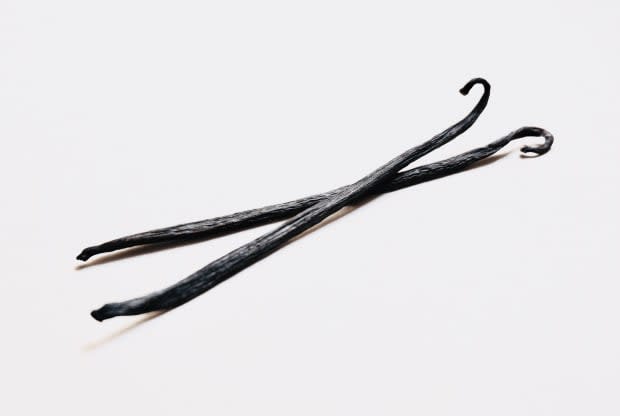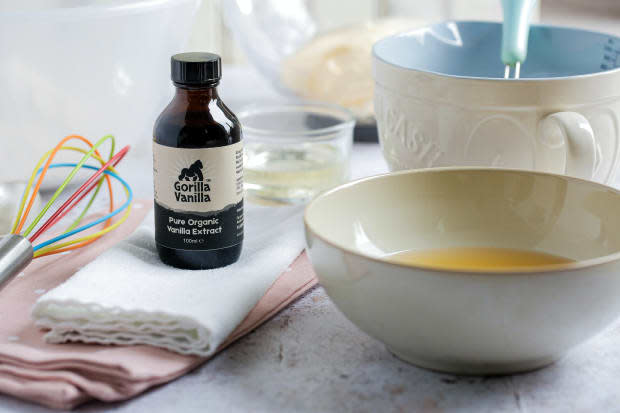Alright, We Love It in Our Lattes, but Where Exactly Does Vanilla Flavoring Come From?
From baking to buying ice cream to ordering a sweet coffee drink, vanilla is absolutely everywhere. But could many of us answer what vanilla actually is? Where does vanilla flavoring come from, anyway?
A mainstay in our society, vanilla has been around for hundreds of years because it is mild, sweet and versatile. "Flavoring," "imitation" and "pure" are the descriptive words commonly used with vanilla.
While vanilla flavoring is available as either artificial vanilla flavoring or as pure vanilla extract, there are many differences between the two options.
Do you know the differences? Let’s dig deeper and find out!

Unsplash
What is vanilla and where does vanilla come from?
Two specific kinds of flowering plants—known as vanilla orchids—provide the pods we commonly refer to as vanilla beans. These vanilla orchids attach to trees much like vines.
It can take anywhere from three to five years before the plants mature enough to produce the vanilla pod for harvest.
The pollination process of vanilla beans is meticulous and somewhat tricky. When the plant begins flowering, growers have only two tools available for pollination: the Melipona bee (located only in Mexico) and themselves. Those areas not fortunate to have that particular bee living among them, must rely on pollination by hand.
There is less than a 24-hour window for pollination once the flower has blossomed, but once that it's done it, it will wilt off the plant and eventually the "fruit" pods will begin to form. After another six months of growing the pods will resemble six- to nine-inch bananas, and are ready for harvest. The vanilla pod then goes through a drying process known as "curing" before it is ready for use.
Where is vanilla grown?
Vanilla is grown in warm, humid climates all over the world. The vanilla-bean-producing orchids can be found throughout India, Indonesia and Papua New Guinea. Mexico and Madagascar are the leading producers, but Madagascar’s climate and fertile soil are the perfect combination for farmers in that region to yield some of the highest quality vanilla.
Vanilla throughout history
Early uses of the vanilla bean go back as far as the 16th century when the Aztecs discovered the pod could be utilized, not only medicinally, but as a flavoring too. Their favorite treat using vanilla was a drink similar to today’s hot chocolate—called xocolatl—a tasty mixture of both cocoa and vanilla.
Although chocolate has been hailed as the first flavor of ice cream, with early recordings in Italy around 1693, vanilla was not far behind. Experiencing vanilla ice cream in France, Thomas Jefferson brought the original recipe for vanilla ice cream home with him to the US, later tweaking it to make his own version.
Mary Randolph’s 1824 cookbook, The Virginian Housewife, was the first published use of vanilla, and that recipe was for (drum roll, please!) vanilla ice cream!
Today, vanilla can be found in various recipes, hair and skincare products—even that favorite candle you burn regularly.
Related: Best Fall Candles
Where does vanilla flavoring come from?
Vanilla flavoring is also known as artificial vanilla flavoring, which is a synthetic alternative to pure vanilla extract. So, what is artificial vanilla flavoring made from?
Synthetically made, the breakdown of the ingredients used to make vanilla flavoring may shock you.
When smelling vanilla flavoring or vanilla extract, you would be hard-pressed to tell the difference between the two, but believe it or not, around 90% of the world’s vanilla flavoring is imitation—lab-created, chemical versions of naturally grown vanilla.
Many not-so-pleasant items can be included in the making of imitation vanilla flavoring. Leftover waste from making paper, clove oil, pine bark and fermented bran to name a few.
Even harder to believe are items like coal tar, cow poop, and beaver gland secretions. (Yeah, you read that right!)
These random items are combined with other chemicals, preservatives and coloring to get the imitation vanilla flavoring we are familiar with in stores—comparable to the pure version in both looks and smell. In fact, most average cooks would find it hard to even tell the difference between the two.
Related: Copycat Starbucks Vanilla Crème Steamer
Where does pure vanilla extract come from?
After a vanilla orchid blossoms, the pods are harvested and added to a potent 35% alcohol solution, which extracts the flavor of the beans into the liquid.
And that finished product is pure vanilla extract.
Fun fact: The vanilla orchid will only bloom one at a time and stay open for that day.

Foodie Flavours on Unsplash
Is there a difference between imitation vanilla and vanilla extract?
The key takeaway is that imitation vanilla—or vanilla flavoring—is a chemically based version, using questionable ingredients, to create a budget-friendly alternative.
Vanilla extract far supersedes the imitation, only containing two ingredients—the actual vanilla bean and alcohol.
So besides the ingredients, and how they are made, price also factors into their differences.
Most recipes allow for either imitation or pure vanilla to be used, swapping out for each other with an equal 1:1 ratio—without any noticeable differences.
What is beaver vanilla?
Some things are better left unknown—but if your curiosity just can’t take it anymore—then yes, we weren't joking when we mentioned beaver gland secretions as a possible ingredient for making imitation vanilla.
When scent-marking their territories, beavers secrete castoreum from their castor sacs located in cavities between the pelvis and the base of their tail. Food additives in flavorings and other commercial products like perfumes have used modified castoreum for a long time, but is less common now, since there are so many other (less disgusting) options for making imitation vanilla flavoring.
Can I make my own vanilla flavoring?
Absolutely! Using just two ingredients, you can create a cost-effective, pure vanilla extract.
Vanilla extract recipe:
Ingredients: Vodka (brandy, bourbon or rum can be used as alternatives), five to six vanilla beans, a jar & time!
Directions:
Cut the vanilla bean in half, lengthwise, using a knife. You may cut the beans down in size to fit the jar if needed.
Put the beans in an 8 oz. jar.
Fill the jar, completely covering the beans, with the vodka (or alternative).
Screw the lid on and shake it.
Now leave in a cool, dark place for at least two months, shaking every week, if possible.
Special note: The longer you wait to use the extract, the stronger the vanilla flavor will be!
Related: Amazing Homemade Vanilla Extract Recipe
Why is vanilla extract so expensive?
Harvested from only certain hot and humid climates, and limited to only two types of plants, vanilla cannot be grown globally.
The predominant regions that supply us with vanilla have also suffered major setbacks due to inclement weather, and waiting for these countries to recover from damages, has led to dwindling vanilla supplies.
Farmers have had no other choice than to raise prices to offset losses, leading consumers to feel it in their pocketbooks when purchasing vanilla extract in stores.
How do I choose a good vanilla flavoring?
You should make the choice of which one to use based on what the recipe calls for, or what suits your needs best!
If you want exceptional quality added to what you are making then make sure you are using actual pure vanilla extract.
Flavoring is artificially made, and doesn’t contain any alcohol—making it less flavorful.
However, flavoring or artificial extract has its purposes—it's hard to distinguish from pure extract in baked goods and is more reasonably priced.
No heat recipes are the only exception to when it is best to use only pure extract. This would apply to frostings, pudding, whipped cream and of course—ice cream!
Does vanilla extract go bad?
Due to the alcohol content of pure vanilla extract, when properly stored, can keep until the cows come home. (Or, maybe until pigs fly…) But extract’s peak freshness is within five years of use.
Helpful tip: There is no need to refrigerate or freeze vanilla extract, even after opening it.
Differences between vanilla and French vanilla
Vanilla comes from the vanilla bean, and is added to alcohol for flavor extraction, or is artificially derived, whereas French vanilla is creamier, richer and definitely sweeter than the other two. French vanilla does not come from France, and is more of a fancy marketing name added items containing it, like that lovely coffee creamer you use everyday. Creamers may use vanilla extract or vanilla flavoring for taste, but can also include dairy, oil, butterscotch, caramel and hazelnut to its delectable ingredients list.
So it may be easier to associate French vanilla as products made with vanilla, than comparing it to vanilla.
Is vanilla extract alcoholic?
Yes!
Vanilla extract is made with no less than 35% alcohol—equivalent to some distilled beverages like gin and brandy. Although alcohol-based, vanilla is monitored by the FDA, and categorized as a food item, making it easily found in any local grocery store.
Next time you are buying your vanilla product whether it is flavoring or extract, take a look at the back of the container at the ingredients list. Does what you will find there change your mind about which one you would buy?
Next up, 22 best vanilla ice cream recipes!